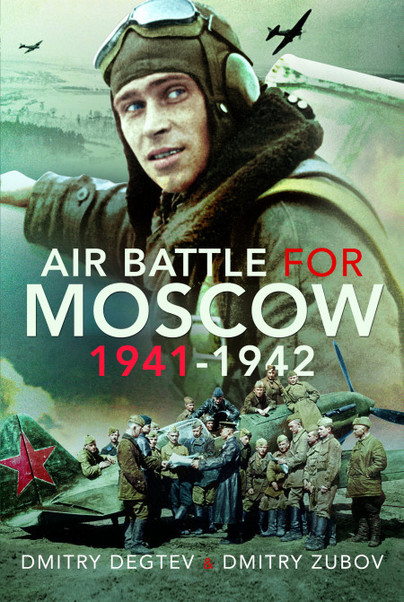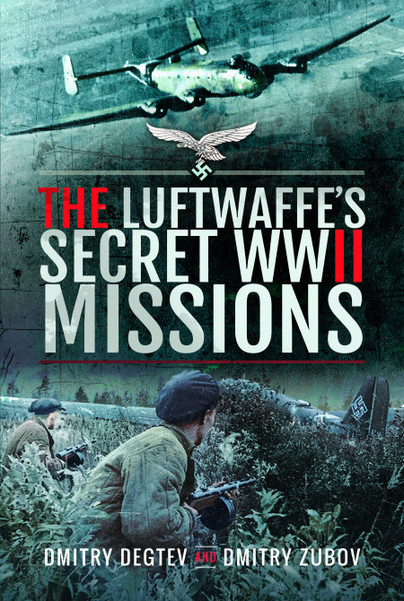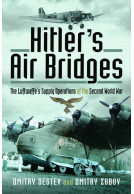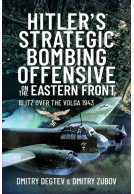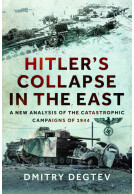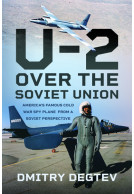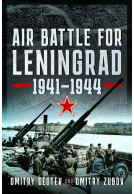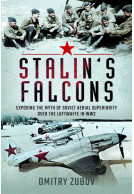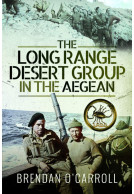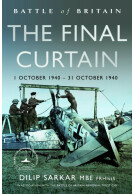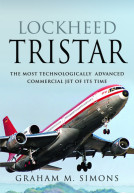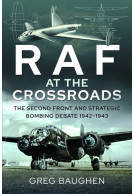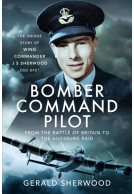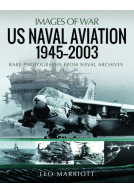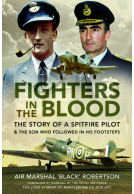Air Battle for Moscow 1941–1942 (Hardback)
Imprint: Air World
Pages: 248
Illustrations: 100 black and white illustrations
ISBN: 9781526774460
Published: 1st September 2021
(click here for international delivery rates)
Order within the next 8 hours to get your order processed the next working day!
Need a currency converter? Check XE.com for live rates
| Other formats available - Buy the Hardback and get the eBook for £1.99! | Price |
|---|---|
| Air Battle for Moscow 1941–1942 eBook (17.6 MB) Add to Basket | £6.99 |
In October 1941, Operation Typhoon and the battle for Moscow began. According to Hitler's plan, it was to be the ‘last offensive’, after which nothing could stop Germany from conquering Britain and the rest of Europe – but first he had to overcome the Soviets and especially their air force.
Air Battle for Moscow is the first detailed description of one of the most vital, yet little known, air battles of the Second World War. The battle for Moscow opened with the flights of long-range reconnaissance aircraft, which photographed Moscow and the Kremlin. Then, on 22 July 1941, Operation Clara Zetkin, the Luftwaffe’s aerial assault on Moscow, began. But the Luftwaffe was opposed by the ‘Stalin's Falcons’, the elite 6th Air Defence Corps, which defended the Soviet capital with a determination which saw bitter duels to the death and horrendous casualties on both sides.
The book presents new facts about this dramatic battle and describes in detail the actions of the aircrew on both sides. Yet this is not just the story or the air war. The authors also describe the lives of people during the war, of suppressed anti-Soviet opposition in Moscow, and of the bloodthirsty and inhuman actions of the Stalin regime. The book also tells of the fate of German pilots caught in Russian captivity, and the adventures of those who were able to survive and escape from the Russian executioners. Many myths concerning the battle are also challenged, such as the often-stated belief that Moscow’s anti-aircraft defences were the most powerful in the world and that it was the Soviets who were the finest pilots.
In this comprehensive account, details of losses, biographical outlines of the key individuals, analyses of the different aircraft and a full chronology of the battle are presented, as well as numerous exclusive photos, documents and drawings.
But it is the stories of those who fought in the Battle for Moscow that, undeniably, have the greatest impact. The harrowing tales of death and survival in conditions that are almost beyond description demonstrate just how important this conflict was to both Russia and the Third Reich and, ultimately, to the outcome of the Second World War.
The book is festooned with one hundred black and white images and illustrations, in a mixture of both photographs, military images, propaganda posters, and even a painting from the period. All of them help to bring the text alive, providing visual engagement with the history. The authors also provide a collection of tables outlining the losses of the opposing sides to help the reader follow the course of the battle, while a number of personal reminisces bring the very human side of the conflict to our attention. All of this makes for a highly interesting book on a long-bypassed part of history. For the modeller it brings new information to the fore, which will help to inform your models of the Great Patriotic War with a collection of reference and images that have not been seen together before.
Scale Aircraft Modelling
There is a wealth of detail about the corps’ activities and aircraft and careful ‘panning’ will provide numerous specks or even nuggets of gold. This work, from Pen & Sword imprint Air World, is certainly worth purchasing by anyone who has a serious interest in Eastern Front air operations.
Royal Aeronautical Society
"...highly recommended for students of the Eastern Front."
Air Power History, Spring 2022
"A 1978 television series about WWII on the Eastern Front was entitled The Unknown War. Air Battle for Moscow might qualify for the same heading in its depiction of events within that conflict about which almost nothing heretofore has been known outside of Russia. That makes this new volume, derived from both Russian and German sources, particularly welcome."
Aviation History
As the title of the book indicates, this particular book concentrates on the air battle over Moscow but it also receives a lot of attention about the ground war. But what we actually have here is a very good book written about the Eastern front and it has been written by two Russian experts and I actually believe particularly history is much better when written by people native to the language of the country. For example, someone local to Moscow is able to get the right access and knowledge from archives, museums, libraries rather than someone coming outside of the country. I enjoyed the technical detail in the book and the book has tables and charts sporadic throughout the book. The book also contains a wide range of photographs particularly from Moscow and of Russian soldiers and people. This book was very informative and well written and I particularly would like to read a second book covering the second half of the war.
UK Historian
Read the full review here
Featured by
Royal Aeronautical Society
This is a very thoroughly researched study, using extensive use of the Central Archives of the Ministry of Defence of the Russian Federation. The basis of the book is therefore a mass of material that is not available to English language researchers. Where possible facts have been cross checked against published German records and accounts. The result is a blow by blow account told with considerable detail regarding the number of sorties flown, the losses on each day and the damage on the ground... So a very valuable addition to the literature of the Eastern front, providing much new material from the Russian perspective.
WW2 Today
Read the full review here
This detailed book puts the air war over Moscow into perspective and ties in the air battle with the ground war as the German onslaught was reaching its high-tide mark. Using Russian archive reports and more recent German secondary sources, the authors weave the two together, to reach a balanced view of the effectiveness of each warring power during this crucial part of Operation Barbarossa.
Chris Kemp
This book prevents a profusion of technical and operational detail, together with anecdotal reports in a coherent fashion. The reader is given a clearer view of an operation that has more usually only received coverage in passing as part of broader coverage of Barbarossa. The book is measured in tone, except where the personality of Richthofen is discussed. The book then slips into language familiar to any student of florid Soviet era prose. This should not deter the reader from an otherwise excellent study of the air campaign that reveals, for example Soviet misidentification and reporting of Luftwaffe aircraft types, the effectiveness of raids on Gorky, and the presence of lend-lease Hurricanes and Tomahawks.
The conclusions reached are not always the ones that might be expected, as the authors challenge the effectiveness of the Soviet air and anti-air defences. They also question the overall effectiveness of the German air offensive, and inflated kill-claims on both sides. The picture that emerges is of a scrappy offensive and defence, hampered by the weather in which, casualties were heavy on both sides. Students of operation Barbarossa, and the air war in particular, will find a good deal in this book to interest them.
The authors have produced an exceptionally well researched and fascinating book on a little-known aspect of the Second World War – The Air Battle For Moscow.
Roger Coleman, The Wessex Branch of the Western Front Association
Dmitry Degtev and Dmitry Zubov are to be congratulated for their dedication and enthusiasm in researching archival material held by the Ministry of Defence of the Russian Federation. Between them they have produced a book of significance not only for those who have a specific interest in aerial warfare but also for those who enjoy reading about 20th century history.
Pen & Sword Books are to be congratulated for bringing yet another Eastern Front view of WW2 to a Western readership.
Philip Styles – Archivist, The Shackleton Association
There are two themes which predominate throughout the narrative. Firstly the land war on a scale not matched in the West - to which that in the air was largely a supporting role - and unremitting over four long years; secondly the ferocity of the conflict involving not only the military but also the civilian populations where, what would now be defined as ‘war crimes’, were almost the norm; but to these the authors add a third, a post-Stalinist view, which highlights how Soviet propaganda hid the nation’s limitations of organisation, training and equipment.
The ‘Air Battle for Moscow’ was not at all the equivalent of that for London; neither Hitler nor his Luftwaffe had planned any sort of aerial ‘blitz’, instead, even this ‘strategic’ assault, was an adjunct to aid the advancing armies. The individual raids were, by London standards, small but aimed at specific targets in which the Luftwaffe achieved some quite marked success. Against them the greatest constraints were those of the vast ranges of the Russian steppes and bomb-load capacity which were both at the limits of their available aircraft.
A first-class and detailed historical record by two superbly well-qualified joint authors.
This almost analytical presentation of facts about the bombings of Moscow by the German Luftwaffe brings to light the problems encountered by the Germans in their attempts to subdue the city and the defence put up by the Russians. The claims are substantiated for both sides and in the 238 pages the story unfolds like a diary citing extracts from published and archive sources. The missions are described, the aircraft used and their payloads. It's a blow by blow account from July 1941 to April 1942 during the heaviest use of bombers by the Germans. There are 8 chapters containing 105 black and white photographs, 17 charts a map and 13 appendices, many of which are a biography of an important personality involved in the conflict. An interesting fact-filled read.
Gary Wenko, IPMS Magazine 1 2021
About Dmitry Degtev
The author of twenty-nine books, DMITRY DEGTEV is one of the leading Russian researchers of the history of the Second World War, having studied the air battles of the Second World War and the history of the Luftwaffe for more than twenty years. He currently lectures at Nizhny Novgorod State Technical University.
About Dmitry Zubov
DMITRY ZUBOV is the author of thirty-two books on military history, published in both Russian and English. Being a professional psychologist, Dmitry is keen to scientifically explore the motives of key characters in the military history of the 20th century. He is critical of the prevailing views regarding the most important events on the Eastern Front, and his books, based on archival sources, present alternative versions of the interpretation of these key episodes of the Second World War. Dmitry has been teaching at Nizhny Novgorod State Technical University for more than fifteen years, including nine years as an Associate Professor, PhD. He now devotes all his time to writing and translating books into English.
The Luftwaffe's Secret WWII Missions (Paperback)
On the night of 14/15 August 1944, the roar of an unknown aircraft was heard over the dense forests to the south-east of Moscow. Flying past the Soviet capital, the aircraft turned towards a ‘secret’ landing site at Yegoryevsk on the outskirts of the city. But lying in wait were troops of Stalin’s elite secret service, SMERSH. The troops turned on the landing lights and the aircraft, a German machine of some description, swept down to land. As the aircraft touched down, some of the SMERSH troops lost their nerve and opened fire prematurely. The German pilot responded quickly and managed…
By Dmitry Degtev, Dmitry ZubovClick here to buy both titles for £38.59







